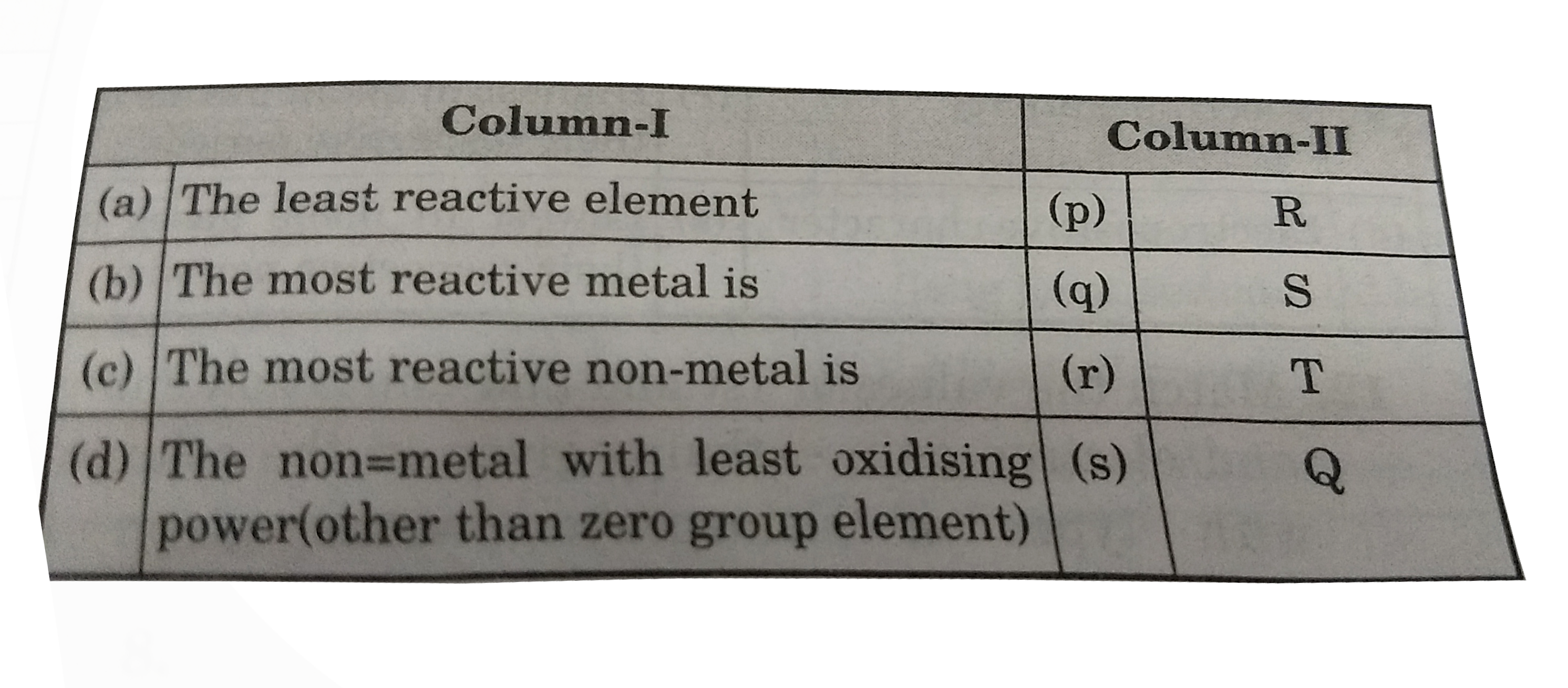The first (ΔiH1) and second (ΔiH2) ionization enthalpies (in kJ mol−1) and the electron gain enthalpy (ΔegH)(in kJ mol−1) of the elements I, II, III, IV and V are given below

the least reactive non - metal and the most reactive metal of these are respectively
IV and V
II and V
V and III
V and II
The correct Answer is:D
Step by step video, text & image solution for The first (Delta_(i)H_(1)) and second (Delta_(i)H_(2)) ionization enthalpies ("in kJ mol"^(-1)) and the electron gain enthalpy (Delta_(eg)H)("in kJ mol"^(-1)) of the elements I, II, III, IV and V are given below the least reactive non - metal and the most reactive metal of these are respectively by Chemistry experts to help you in doubts & scoring excellent marks in Class 12 exams.
Updated on:21/07/2023Topper's Solved these Questions
Similar Questions
The first (ΔH1) and second (ΔH2) ionisation enthalpies (in kJmol−1) and the (ΔHeg) electron gain enthalpy (in kJmol−1) of a elements are given below:

Based on the above information match the following columns.

View SolutionIonisation enthalpy (ΔiH kJ mol−1) for the elements of group 13 follows the order.
View Solution
Knowledge Check
The first (ΔIH1) and second (ΔIH2) ionisation enthalpies (in kJ mol−1) and the (ΔegH) electron gain enthalpy (in kJ mol−1) of a few elements are given below:

The least reactive element is :APBQCRDTIonisation enthalpy (ΔiH kJ mol−1) for the elements of group 13 follows the order.
AB > Al > Ga > In > TlBB < Al < Ga < In < TlCB < Al > Ga < In > TlDB > Al < Ga > In < TlIonisation enthalpy (ΔtHlinkJmol−1) for the elements of group-13 follows the order
AB>Al>Ga>In>TIBB<Al<Ga<In<TICB<Al>Ga<In>TIDB>Al<Ga>In<TI
The first (ΔiH1) and second (ΔiH2) ionisation enthalpies (inkJmol−1) and the (ΔegHө) electron gain enthalpy (inkJmol−1) of a few elements are given below:
Elements(ΔiH1)(ΔiH2)ΔegHөI5207300−60II4193051−48III16813374−328IV10081846−295V23725251+48VI7381451−40
Which of the above elements is likely to be
a. the least reactive element.
b. the most reactive metal.
c. the most reactive non-metal.
d. the least reactive non-metal.
e. the metal which can form a stable binary halide of the formula MX (X=halogen).
f. the metal which can form a predominantly stable covalent halide of the formula MX(X=halogen).
View SolutionThe first (ΔiH1) and second (ΔiH2) ionisation enthalpies (inkJmol−1) and the (ΔegHө) electron gain enthalpy (inkJmol−1) of a few elements are given below:
Elements(ΔiH1)(ΔiH2)ΔegHөI5207300−60II4193051−48III16813374−328IV10081846−295V23725251+48VI7381451−40
Which of the above elements is likely to be
a. the least reactive element.
b. the most reactive metal.
c. the most reactive non-metal.
d. the least reactive non-metal.
e. the metal which can form a stable binary halide of the formula MX2 (X=halogen).
f. the metal which can form a predominantly stable covalent halide of the formula MX(X=halogen).
View SolutionWhy do halogens have high electron gain enthalpies (i.e. −ΔegH⊙)?
View SolutionThe second electron gain enthalpies (in kJ mol−1) of oxygen and sulphur respectively are:
View SolutionThe first (ΔiH1 and second (ΔiH2 ionization enthalpies (in kJ/mol) and electron gain enthalpy (in kJ/mol) of few elements are given below:
ElementsΔiH1ΔiH2ΔegHI5207300−60II16813374−328III8991757+48IV23725251+48
Which of the above is likely to be He:
View Solution
